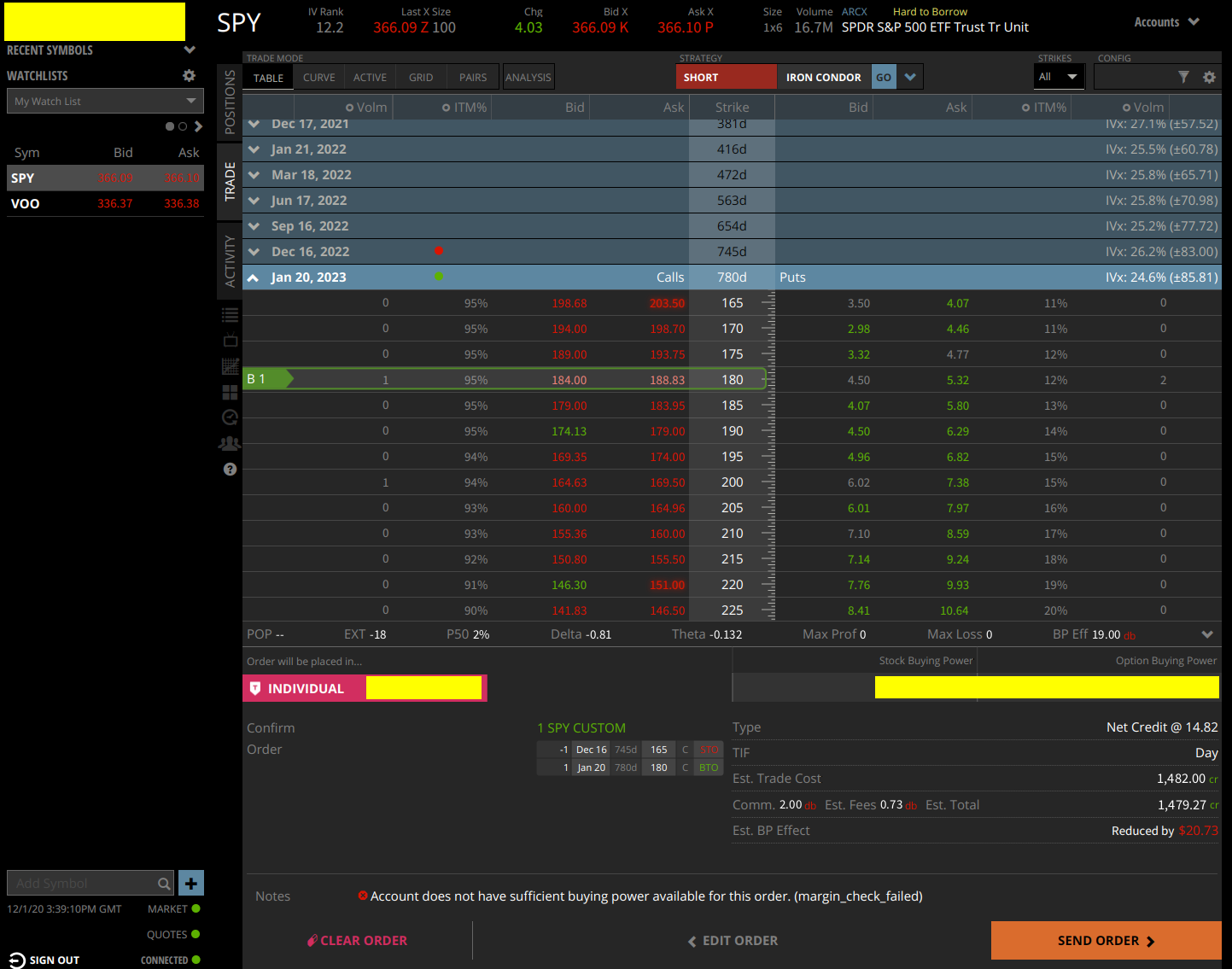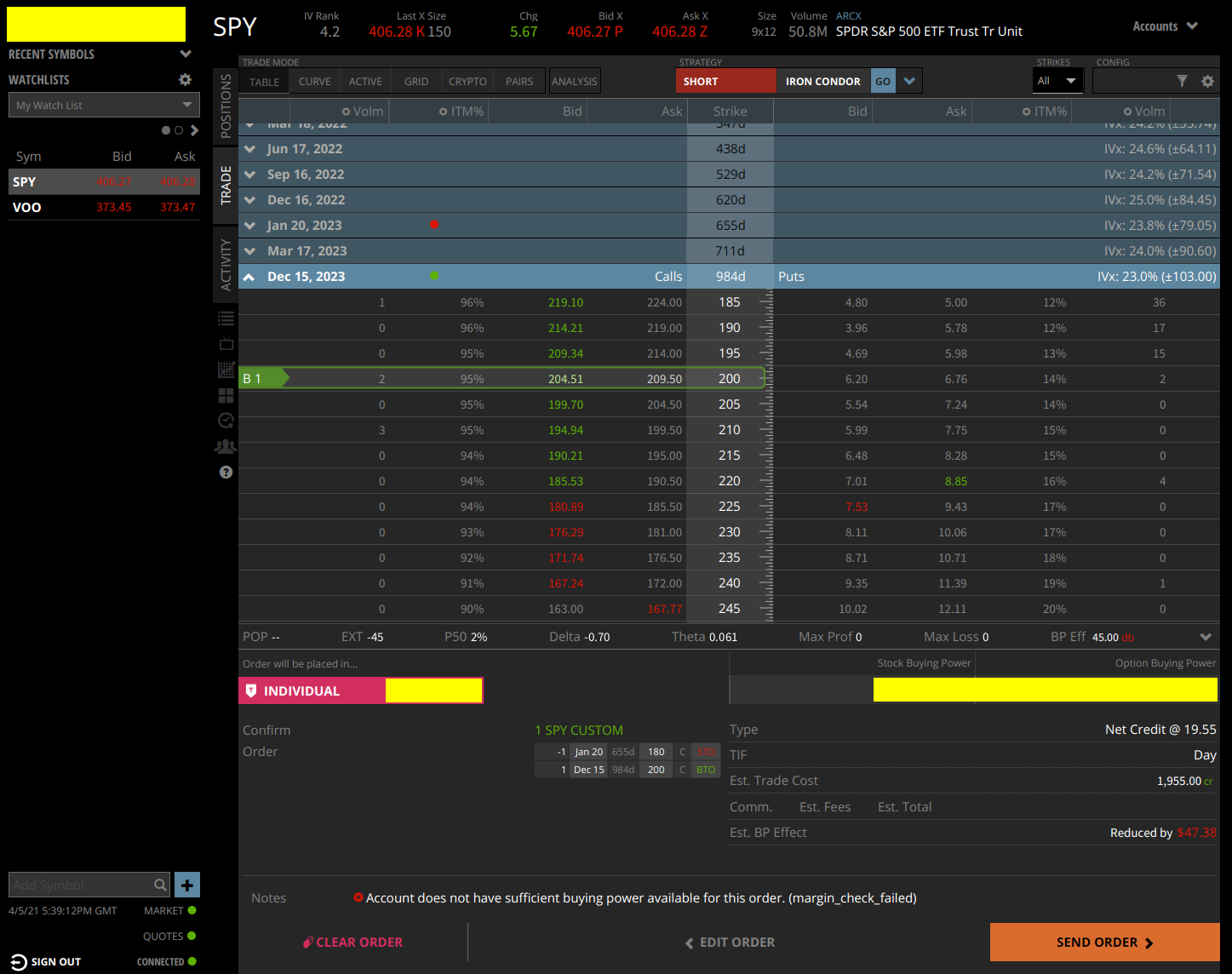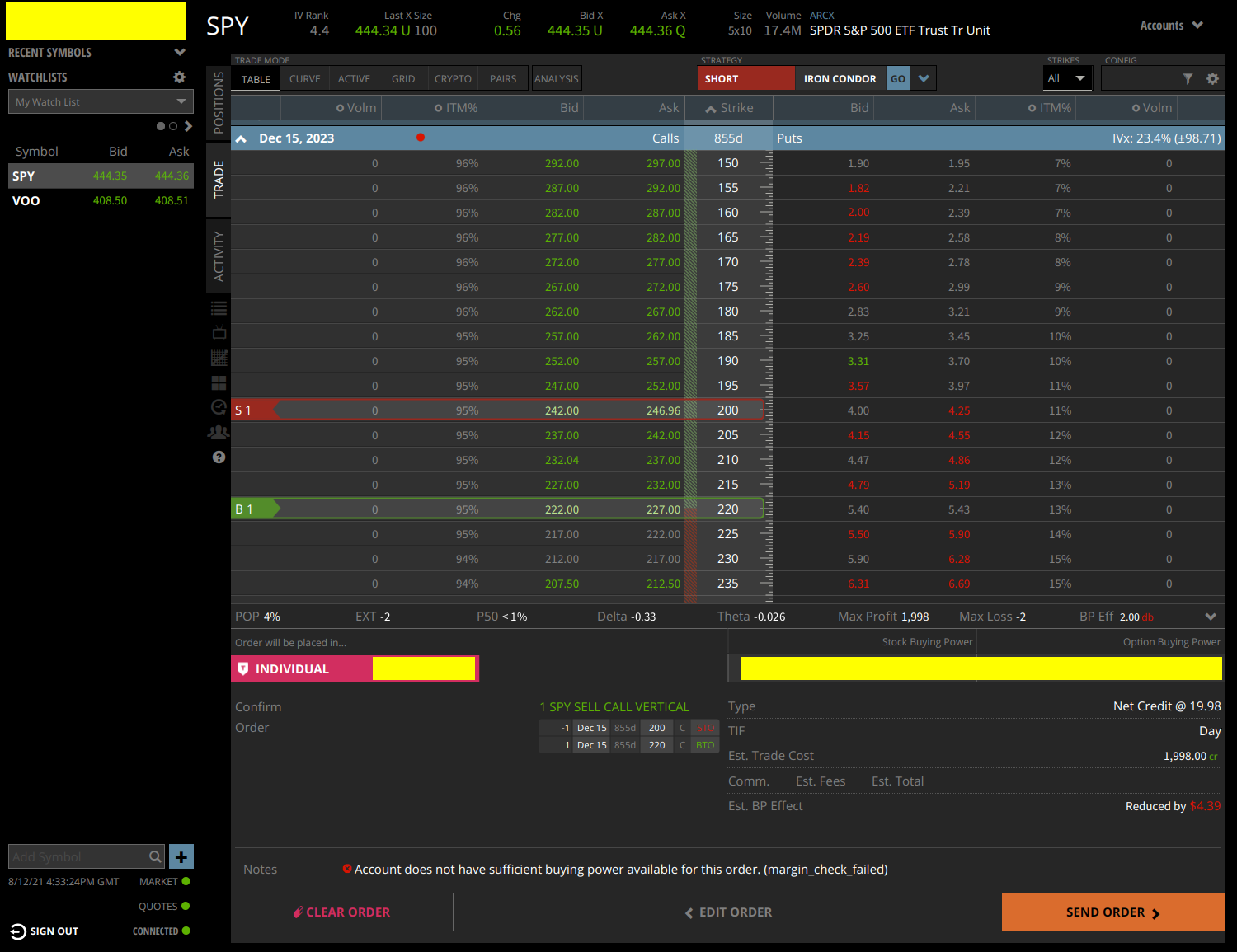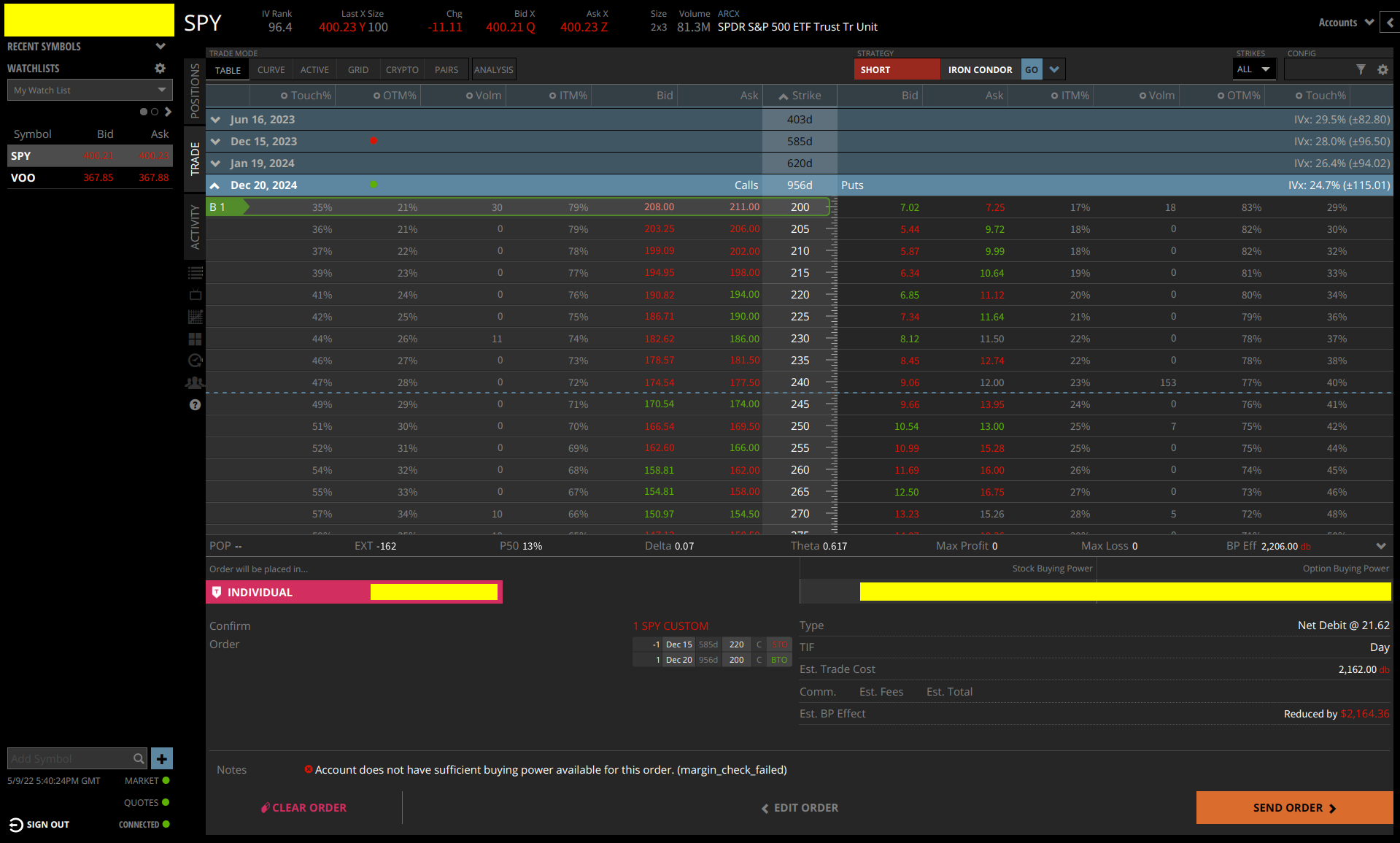We’d like to remind Forumites to please avoid political debate on the Forum.
This is to keep it a safe and useful space for MoneySaving discussions. Threads that are – or become – political in nature may be removed in line with the Forum’s rules. Thank you for your understanding.
Mr.Saver's Long-term Leveraged Investment Strategy Using LEAPS
Comments
-
Screenshot of the price used for today's transaction

0 -
The trading log is here: https://forums.moneysavingexpert.com/discussion/comment/76843235#Comment_76843235
Screenshot of the price used for today's transaction. The commission and estimated fees are somehow not available this time. Based on the costs from the previous transaction, I estimated the commission should be $2, and fees should be about $0.80.
0 -
The trading log is here: https://forums.moneysavingexpert.com/discussion/comment/76843235#Comment_76843235
Screenshot of the price used for today's transaction. Again, the commission and estimated fees are not available. I will use the same estimation as above - $2.00 commission and $0.80 fees.
0 -
S&P 500 went down a lot in the last month, it's time to rebalance and restore the leverage ratio back to the desired range.
Trading log: https://forums.moneysavingexpert.com/discussion/comment/76843235#Comment_76843235
Screenshot of the price used for today's transaction, assuming $2.00 commission and $0.80 fees.
0 -
I bought a property much earlier than I originally planed. That means I had to liquidate everything in this account and some other accounts in order to fund the property purchase.Deleted_User said:So this thread started out as a record of your real-time trades using a strategy intended for the long term, but you actually abandoned the strategy after a matter of months, since when it's just theoretical?!I must say I don't see the point, now that it's no longer a record of real trades. A strategy doesn't work if you don't stick to it, and you didn't (even if the reasons for that were changes in your life plans ... that is a relevant lesson: investment strategies have to fit into your life plans).You said here - https://forums.moneysavingexpert.com/discussion/comment/77588189/#Comment_77588189 - that you would probably end up with a small loss from period you were actually following the strategy (after taking into account all costs). I think the strategy was meant to be an alternative to just holding a S&P500 tracker? So what would the returns been for just holding a S&P500 tracker over the same period? That seems to me like the relevant comparison.
For now, this has become a virtual account, but I plan to make it real again after I build up enough cash outside tax wrappers. This will take some years, because my expenditures have gone up a lot after buying the property and 1 option contract currently costs over $20k, and I can foresee this is going to go up quiet a lot in the next few years.
The strategy is never meant to be an alternative to holding a S&P 500 tracker. The strategy is intended to create a 2x leverage from options, which will amplify both gains and losses. The appropriate benchmark should be borrowing at market rate (~3% via consumer loans) and invest it along side with same amount of the investor's own cash in a S&P 500 tracker. I didn't calculate the theoretical profit/loss of the loans and S&P 500 tracker, but the results should be fairly close to what the strategy has done.Deleted_User said:So this thread started out as a record of your real-time trades using a strategy intended for the long term, but you actually abandoned the strategy after a matter of months, since when it's just theoretical?!I must say I don't see the point, now that it's no longer a record of real trades. A strategy doesn't work if you don't stick to it, and you didn't (even if the reasons for that were changes in your life plans ... that is a relevant lesson: investment strategies have to fit into your life plans).You said here - https://forums.moneysavingexpert.com/discussion/comment/77588189/#Comment_77588189 - that you would probably end up with a small loss from period you were actually following the strategy (after taking into account all costs). I think the strategy was meant to be an alternative to just holding a S&P500 tracker? So what would the returns been for just holding a S&P500 tracker over the same period? That seems to me like the relevant comparison.
0 -
It may sound like a bad idea initially, but please allow me to explain it.Deleted_User said:Hmm ... investing money borrowed via consumer loans sounds like a really bad idea, so I'm not sure what it would prove if your strategy did favourably compared to that?? ... The broader point is: why would you put money into your strategy at all?
The long run stock market's average return is higher than consumer loan's interest rate today. The expected global stock market nominal return is somewhere between 5% and 9% annually, depends on how optimistic you are. At the same time, the consumer loan's interest rate can be as low as less than 3%, and it's fixed for the lifetime of the loan. This ensures borrow to invest is profitable in the long run.
You may say, that doesn't make it less risky. You are right. That's where the next point comes in handy.
A young person has very little financial capital available today, but as they get older, they convert their human capital to financial capital (i.e. work). If the young person have a stable job, they could treat their human capital as a bond. They essentially are over-weighting bonds and under-weighting equities when they are younger, even if they've invested all of their money in equities. To help balance the bond-equity allocation, they can borrow money to invest in equities. Keep in mind borrowing money is effectively shorting a bond. Doing this actually reduces their lifetime market risk, because they could accumulate more wealth in the early years, and that in turn will enable them to take less market risk in latter years when they have much more money in the game.
So, it's actually profitable and less risky than traditional asset allocation strategy over a person's lifetime. Why shouldn't I do it?
A side note: a little leverage is good, but too much leverage is very bad. The profitability is highest in between 1.5x to 2x leverage, but it becomes less profitable with higher leverage rate. At 4x or more the entire portfolio can be wiped out (i.e. 100% loss) in a bad market.0 -
You need to compare the lifetime risk-adjusted returns. Because this strategy does not intend to use leverage permanently. The leverage will reduce and eventually disappear as the person gets older.Deleted_User said:You're trying to defend the idea of leveraged investment in equities, and at the same time you don't think the results of your chosen leveraged strategy should be compared to the results of the most obviously comparable non-leveraged strategy for investing in equities? I'm out.
For the same reason that you don't take one leg of a hedged position out alone and compare it to a buy-and-hold strategy, you should not compare the first half of this this strategy (2x leveraged) alone to a buy-and-hold strategy. It's apples and oranges. You need to compare the risk-adjusted return of the entire strategy, including the second half which will have less equity exposure than standard buy-and-hold strategy.
If you are interested, here's the paper comparing this strategy to more widely adopted investment strategies, back tested using historical stock market returns.https://papers.ssrn.com/sol3/papers.cfm?abstract_id=1149340By employing leverage to gain more exposure to stocks when young, individuals can achieve better diversification across time. Using stock data going back to 1871, we show that buying stock on margin when young combined with more conservative investments when older stochastically dominates standard investment strategies—both traditional life-cycle investments and 100%-stock investments. The expected retirement wealth is 90% higher compared to life-cycle funds and 19% higher compared to 100% stock investments. The expected gain would allow workers to retire almost six years earlier or extend their standard of living during retirement by 27 years.
0 -
Mr.Saver said:The strategy is never meant to be an alternative to holding a S&P 500 tracker. The strategy is intended to create a 2x leverage from options, which will amplify both gains and losses. The appropriate benchmark should be borrowing at market rate (~3% via consumer loans) and invest it along side with same amount of the investor's own cash in a S&P 500 tracker. I didn't calculate the theoretical profit/loss of the loans and S&P 500 tracker, but the results should be fairly close to what the strategy has done.Borrowing money on consumer loans is very different from your strategy, because investing borrowed money risks >100% losses.For all its faults, the maximum loss from buying LEAPS is only 100%.On the other hand, if you can reduce the risk of being forced to cash in an S&P 500 tracker to repay your loan, the extra risk from borrowing to invest in a tracker can be reduced. It could even be reduced to zero (i.e. with access to the Bank of Mum and Dad) which leaves you with all the upside. The downside risk can be controlled by the investor depending on their job and willingness to make lifestyle changes.With this strategy the downside risk is entirely at the mercy of the markets - the risk that the LEAPS expire without value, or enough of them expire that it creates a permanent loss that the upside doesn't compensate for.As we saw in practice, you can also run into the problem that you have to abandon the strategy due to not having enough funds to afford a single option. In which case your only option is to invest in a conventional S&P 500 tracker, meaning you get the amplified downside but non-amplified upside.I agree with FeralHog's take. The strategy failed in 2020 when you had to abandon it, firstly due to your bankroll falling below the minimum stake, and then after you cashed in what was left due to a lifestyle change, thankfully with limited losses. The thread will now probably die as nobody is interested in virtual portfolios.If your virtual portfolio goes up during the next bull market it doesn't really tell us anything. A leveraged investment should outperform a conventional tracker if markets go up. The interesting thing is what happens when someone is bullish enough about the current market high to actually put their money in it. Just before, whodathunk it, the market crashes. But that story's already ended.0
-
The risk of borrowing from a consumer loan is mitigated by having a stable job, access to emergency fund and emergency borrowing (friends and family members), arranging a payment holiday with the lender and reducing spending. There's many ways to avoid selling at bottom. The bottom line is, the job needs to be reasonably safe and produce a stable stream of income regardless of the economic conditions. I fortunately have such a job, getting above inflation pay raises when many others were furloughed or made redundant.Malthusian said:Borrowing money on consumer loans is very different from your strategy, because investing borrowed money risks >100% losses.For all its faults, the maximum loss from buying LEAPS is only 100%.On the other hand, if you can reduce the risk of being forced to cash in an S&P 500 tracker to repay your loan, the extra risk from borrowing to invest in a tracker can be reduced. It could even be reduced to zero (i.e. with access to the Bank of Mum and Dad) which leaves you with all the upside. The downside risk can be controlled by the investor depending on their job and willingness to make lifestyle changes.
Both are not true.Malthusian said:With this strategy the downside risk is entirely at the mercy of the markets - the risk that the LEAPS expire without value, or enough of them expire that it creates a permanent loss that the upside doesn't compensate for.As we saw in practice, you can also run into the problem that you have to abandon the strategy due to not having enough funds to afford a single option. In which case your only option is to invest in a conventional S&P 500 tracker, meaning you get the amplified downside but non-amplified upside.
The LEAPS contracts will not expire without value, because the rebalancing strategy would have sold it when the market is down by 10% (far before it's down 50%), and crystallise a loss of approximately 20%. Then either buy a lower strike or move to 100% ETFs. As the market recovers, the strategy will rebalance it back to higher strike if it had bought a lower strike, or reenter the option market if moved to 100% ETFs. The only thing gets lost in this process is the transaction cost.
Keep in mind that the 50% ITM option contract will only cost $1 more for every $2 increase in the underlying ETF price, this ensures the strategy will eventually be able to get back to options if it had temporarily moved to 100% ETFs.
It failed to maintain the 2x leverage in 2020, but that did not wipe out the portfolio. There's a big difference between these two. Even without the leverage, it still earns the market return, because it will be invested in the S&P 500 ETFs. Also, as the market recovers, the strategy will get back to the options.Malthusian said:I agree with FeralHog's take. The strategy failed in 2020 when you had to abandon it, firstly due to your bankroll falling below the minimum stake, and then after you cashed in what was left due to a lifestyle change, thankfully with limited losses.
I sold some investments at a loss doesn't mean it's a failure of the investments. In fact around the same time I've also sold some FTSE All Share funds with a loss. Does that mean investing in FTSE All Share (as a part of a portfolio) is also a bad strategy? I don't think so.
This is never a market timing strategy, the success of it doesn't depend on bull markets. It depends on the stock market return exceeding the borrowing cost in the long run, which is true for any 20 years time frame from the price history of S&P 500.Malthusian said:The thread will now probably die as nobody is interested in virtual portfolios.If your virtual portfolio goes up during the next bull market it doesn't really tell us anything. A leveraged investment should outperform a conventional tracker if markets go up. The interesting thing is what happens when someone is bullish enough about the current market high to actually put their money in it. Just before, whodathunk it, the market crashes. But that story's already ended.
It's a strategy intended to run for 30+ years, with gradually reduced leverage rate, and eventually stop using leverage.
In short, it works like this:
at the beginning, invest 200% in equity (using 2x leverage)
many years latter, start to gradually reduce the leverage
once the leverage is gone, gradually adding bonds
at retirement, it's a classical equity bond portfolio, such as 60-40 or even 50-50
1 -
I've tried various forms of leverage. It's interesting because it has the potential to produce astonishing returns when compounded over time.
I find the mortgage your retirement idea easy to implement. For example, I didn't have any spare cash last year so borrowed £40k using an additional mortgage to fill up our ISAs.
I find the separation between the assets and the debt helpful psychologically. I can afford the repayments which are lumped in with the rest of the mortgage that went towards the house. I'm not going to sell the shares which are lumped in with the rest of my investments. I don't really track the two together. If the shares go down, I will have in theory lost more than the £0 of my own money I put in but it is just part of my overall personal balance sheet so I don't care.
It is much more difficult to stick to when the leverage is built into the product. Having busted out of many futures contracts last year, I can tell you it isn't much fun. Even if you believe in the strategy long term, it is difficult to keep putting money in when you keep losing. I doubt many people have managed to do it consistently for 30 years.
I haven't given up on the idea. If the markets keep falling, I may try again with lower leverage and more frequently rebalancing.
I also recently purchased my first leveraged ETF.1
Confirm your email address to Create Threads and Reply

Categories
- All Categories
- 352.4K Banking & Borrowing
- 253.7K Reduce Debt & Boost Income
- 454.4K Spending & Discounts
- 245.4K Work, Benefits & Business
- 601.2K Mortgages, Homes & Bills
- 177.6K Life & Family
- 259.2K Travel & Transport
- 1.5M Hobbies & Leisure
- 16K Discuss & Feedback
- 37.7K Read-Only Boards




